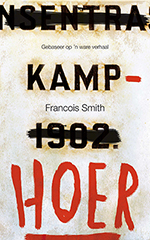
Cover of the novel Kamphoer |
Fact and fiction came together at the Bloemfontein Campus recently to discuss the traumatic repercussions of the South African War. The event forms part of a three-year project – headed by Prof Pumla Gobodo-Madikizela (University of the Free State Trauma, Forgiveness, and Reconciliation Studies) – which investigates transgenerational trauma in the aftermath of the South African War.
The discussion explored the theme, ‘Working through the Past: Reflections on the novel Kamphoer’.
Together, Emeritus Prof Chris van der Merwe (University of Cape Town) and the author of the novel, Dr Francois Smith (University of the Free State, Department Afrikaans and Dutch, German and French), engaged in a thought-provoking, insightful conversation, tracing themes of trauma and issues of forgiveness presented in Kamphoer. Prof Van der Merwe and Dr Smith demonstrated how both fiction and historical fact can inform our present, and guide us into the future.

Emeritus Prof Chris van der Merwe and Dr Francois Smith
discuss the novel Kamphoer and how the book relates to
current issues of transgenerational trauma. |
“On a societal level,” Prof Van der Merwe said, “we need to work through trauma by putting it into words, and putting it into a narrative.” When it comes to historical trauma, should we forgive and forget, though? Or rather remember and retaliate? Neither, proposed Prof Van der Merwe. “What I want to plead for is the difficult challenge: remember and forgive.” But Prof Van der Merwe also pointed out that, although forgiveness blesses both the giver and receiver, it is an ongoing process.
Dr Smith agreed wholeheartedly. “One of the discoveries of my book is that forgiving is a continuous process. It’s not something that gets completed at a particular stage in your life. By the same token, you can’t say that you are ever able to leave the past behind.” These issues of trauma, forgiveness, the past versus the present, remembering and forgetting are all integral questions confronting the main character of the novel, Susan Nel .
They are also questions we, as a nation, are currently confronted with, too.
“At this moment in our society,” Prof Van der Merwe said, “we have enough killers. We have a greater need now for caring nurturers.”